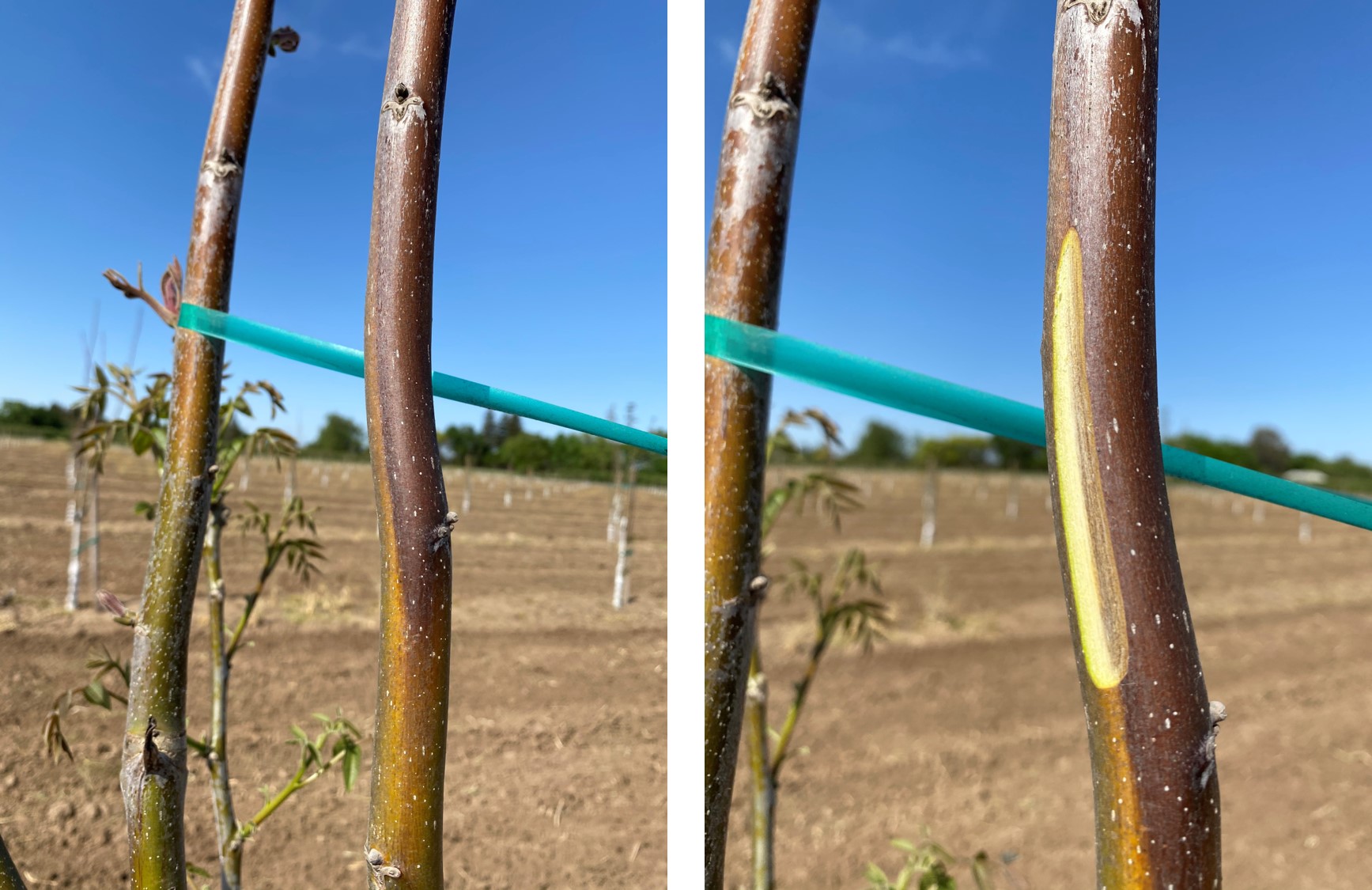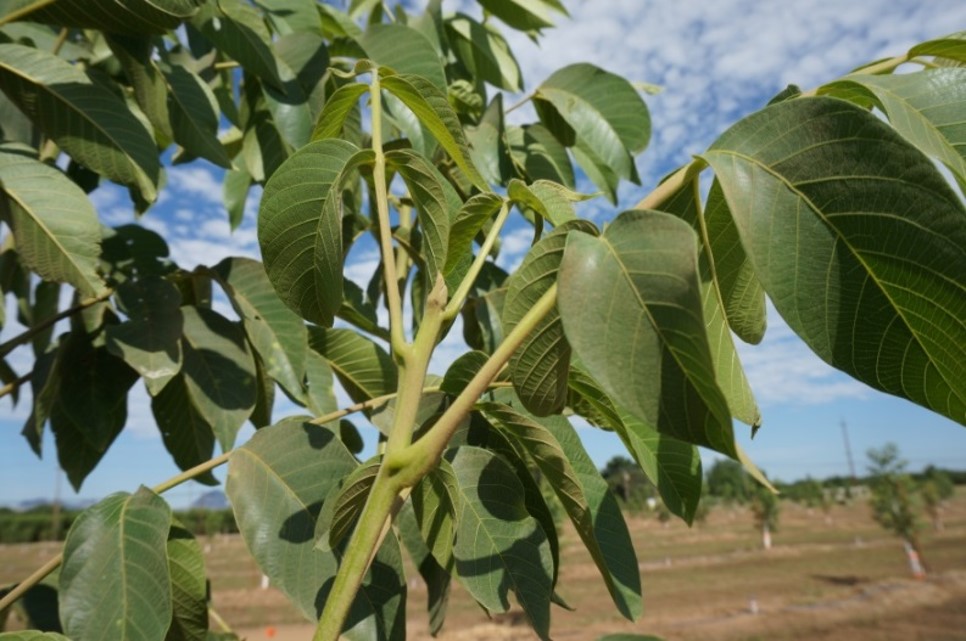
Walnut growers, particularly those in the northern Sacramento and San Joaquin valleys, used to view sudden fall freezes as a one-in-seven- or one-in-10-year occurrence. But consecutive freezes during the past three autumns may cause them to change their thinking and become more prepared for cold snaps before leaf drop.
“This is something that’s going to have to be on [walnut growers’] radar,” said Luke Milliron, a University of California Cooperative Extension orchard systems advisor for Butte, Glenn and Tehama counties. “My perception is walnut growers see these freeze events in fall as less predictable, and they creep up on them and take them by surprise.”
One of UCCE’s main recommendations for preparing trees for cold snaps is to ensure adequate soil moisture levels, whether from natural precipitation or irrigation, by the end of October. But Milliron said that may be more difficult this season with irrigation districts curtailing deliveries or shutting off water early. Even some growers with groundwater may have difficulty because some wells have gone dry.
Wide Temperature Fluctuations
Mohamed Nouri, a UCCE orchard systems advisor for San Joaquin County, and his Stanislaus County counterpart, Kari Arnold, analyzed data from a CIMIS weather station near Manteca from 2018-2020. In mid-November 2018, temperatures dropped suddenly to between 26 and 29 degrees Farenheit for a few days, injuring both young and mature orchards. But the damage wasn’t as widespread as in 2020.
Fortunately, growers went through the 2019 winter with little stress to young and mature walnut orchards. Temperatures were warm enough and the weather was wet enough to protect the trees, Nouri said.
This was not the case in November and early December 2020, he said. The temperature dropped below freezing on November 9 and 10, then continued to fluctuate during the end of November and early December 2020, which caused enormous stress to trees. Nouri said the dry fall also could make freeze damage worse.

Be Prepared
To prepare trees for potential fall cold snaps, UCCE has developed a set of recommendations. For both young and mature trees, they recommend finishing nitrogen applications by the end of August.
For young trees, they suggest stopping irrigation for the first two weeks in September or until a terminal bud is set on the trunk of young trees to stop new tender growth in autumn. After the terminal bud is set, resume irrigation to avoid tree stress and defoliation and without the fear of pushing new growth.
If there has not been adequate rainfall by the end of October, irrigate young and mature orchards so the soil is moist going into November, and then continue monitoring soil moisture throughout November. Rainfall adequacy can be determined by comparing rainfall totals with evapotranspiration, or ET, rates and monitoring soil moisture levels by hand or with sensors. Trees with adequate soil moisture are better able to withstand low temperatures without damage than trees that are dry. That’s because water conducts and stores more heat than air spaces.
Continue to actively monitor soil moisture and freeze predictions in November. If a freeze is predicted and the soil is dry, it should be wetted two to three days before a freeze to fill the air spaces so the soil will store more heat. The top foot is the most important and should be at field capacity but not too wet.
And avoid water on the soil surface before a freeze since it will freeze solid. And much like a dry surface crust, it will prevent the radiation of stored heat during the night.
Nouri said irrigating an orchard a few days before a forecast freeze is a good practice and will ensure trees are hydrated enough before the freeze occurs. “There are a lot of things that still need to be investigated to know how we can mitigate and prevent this type of damage.”
To that end, Nouri said he and other farm advisors are developing a grower survey to try to tease out practices that worked and didn’t work during the 2020 freeze.

A Long-Standing Practice
Gary Enos, who is part of Carriere Family Farms near Glenn, said the 2020 freeze was unexpected. But their usual late-fall irrigation helped them get by with only scattered damage in low spots.
“For us, it’s a matter of practice,” he said. “We’ve seen this before, and as dry as the ground was, we knew we had to get moisture into the trees.”
Enos said they are fortunate to have wells they could use after the district finished deliveries for the season.
The spotty damage they sustained was on the lower sides of the fields, where temperatures dipped a few degrees from the higher areas.
“Just those few inches can make a difference,” Enos said.
Listening to Advice
Ken Vogel, who grows cherries and walnuts with his son near Linden, said he also escaped 2020 with minimal winter kill. Although one block of Chandlers seemed to have a bit of damage, his other Chandler blocks as well as other varieties had very little.
Vogel credited his PCA, who told him to start irrigating a day or two before the cold snap, for his trees’ health. Unlike growers in other parts of San Joaquin County who are on district surface water, Vogel relies on groundwater and has wells he can turn on when needed.
“We try to always listen to advice,” he said. “That was pretty extreme. It was 80 degrees a couple of days before, then it dropped to a low of 26 for a few hours. A grower on Copperopolis [Road] was hit pretty hard. They also were hit hard up to the east. We did pretty well.”
Vogel’s one Chandler block that didn’t fare as well was on an old English rootstock promoted until it fell out of favor in the 1980s. He said he wasn’t sure whether the dead wood he saw was the result of the cold weather or from annual attrition caused by the rootstock.
Vogel, who didn’t have any damage during the 2018 and 2019 cold snaps, said he tries to make his last nitrogen application by the first week of August. A grower he knows who also sustained cold-related damage in 2019 applied nitrogen in mid-October, Vogel said.

If You Suspect Freeze Damage
If you suspect freeze damage in the fall or winter, cut into the branches and check the tissue for drying or browning. Subsequent sunburn can further damage tissue on the southwest side of trees.
Paint the southwest side of damaged trees with a mixture of 50% water and 50% latex paint. Applying this homemade whitewash up to a week after the freeze can decrease damage by half or more.
Also, don’t be in a hurry to prune in the spring. With freeze-damaged wood, budbreak can be significantly delayed. But in some cases, the buds from deep in the bark may grow to rejuvenate a limb.
Wait until at least mid-June to prune out the dead wood that did not revive, according to UCCE. New scaffolds that grow can be trained to replace the damaged wood. It’s a balancing act to wait for new growth from damaged trees while also giving yourself enough time to clean up the orchard ahead of harvest.
Will History Repeat?
In 2018 and 2019, many Sacramento Valley and northern San Joaquin Valley walnut growers experienced orchard damage from sudden freezes. But 2020 proved even worse when early November temperatures topped out at 80 before dropping to below freezing on Nov. 10 and 12.
The large temperature swings could help explain the severe tree damage seen this spring. During warm daytime temperatures, tree limbs contain starch, which doesn’t provide freeze protection, according to studies by UC Davis Plant Physiologist Maciej Zwieniecki.
Slow cooling is needed to promote starch degradation into sugars. This chemical conversion helps protect against ice formation in plant cells that could otherwise cause them to burst. Think of it as Mother Nature’s antifreeze.
In November 2020, temperatures dropped about five degrees per hour, which interfered with this conversion. That meant the trees were more susceptible to cold injury.
In addition, pomologists believe several nights of temperatures at or just above 32 F are needed to harden walnut trees off and provide cold-temperature tolerance ahead of subfreezing temperatures. There had only been one night near 32 F before the Nov. 10 to 12 freeze.
Much of the 2020 freeze damage didn’t become apparent until this spring when walnut trees didn’t leaf out or had delayed leafing. Although hundreds of acres were affected in each county, Milliron said they didn’t meet the 30% minimum acreage threshold needed for a county disaster declaration.
It also appeared more severe in the northern Sacramento Valley and northern San Joaquin Valley compared to the southern Sacramento Valley, which was especially hard hit by the November 2018 freeze but largely spared in 2019 and 2020.
















